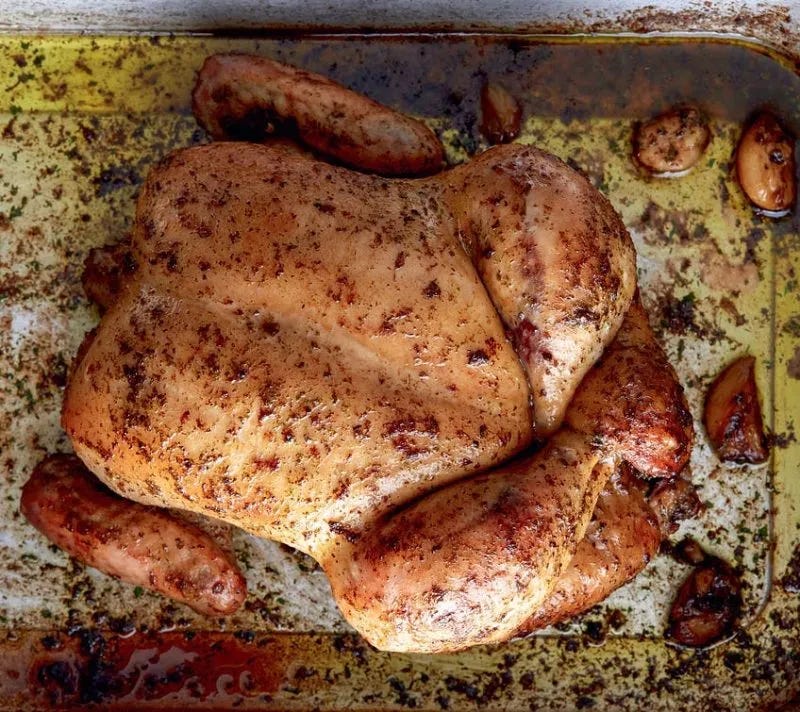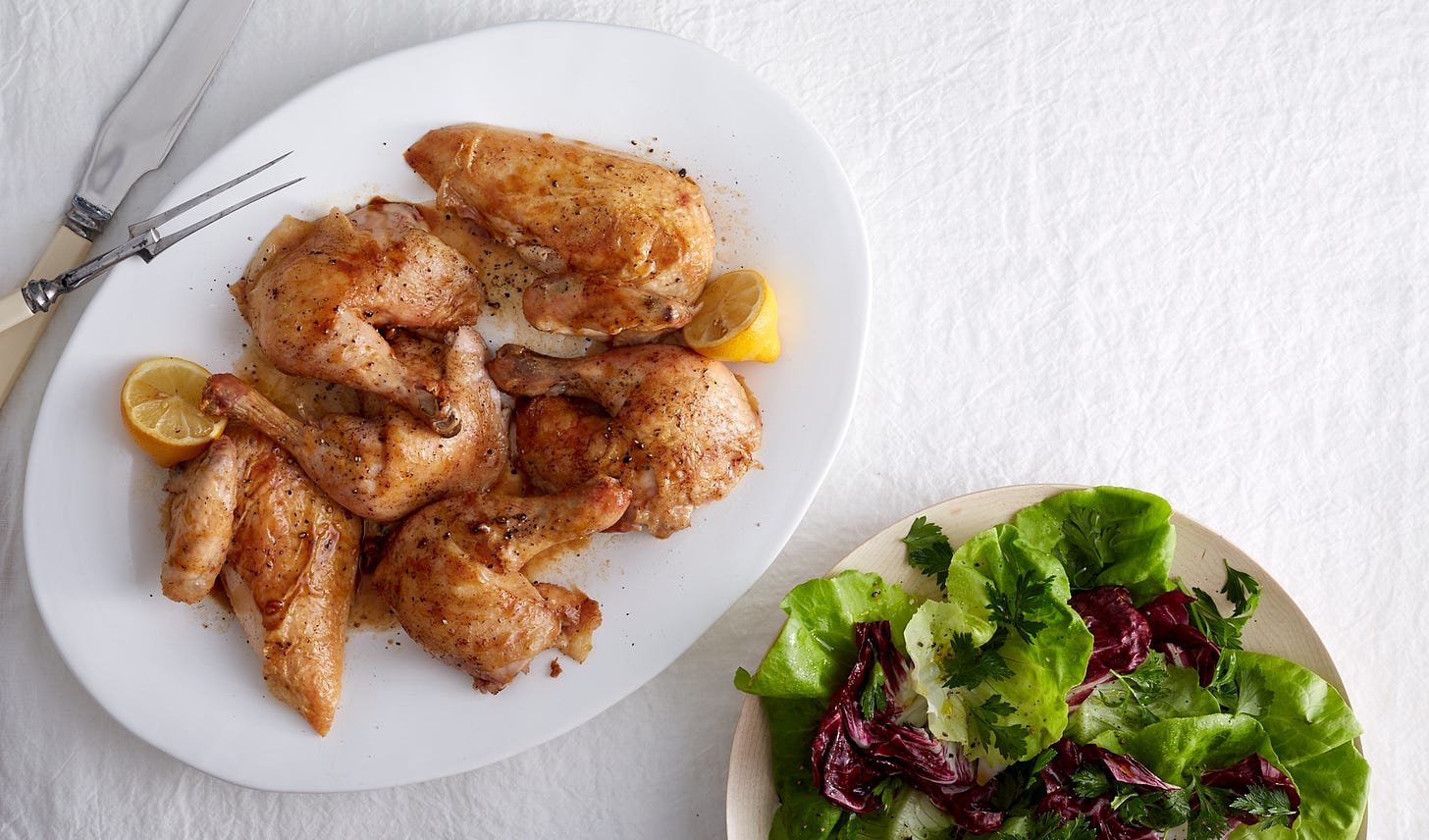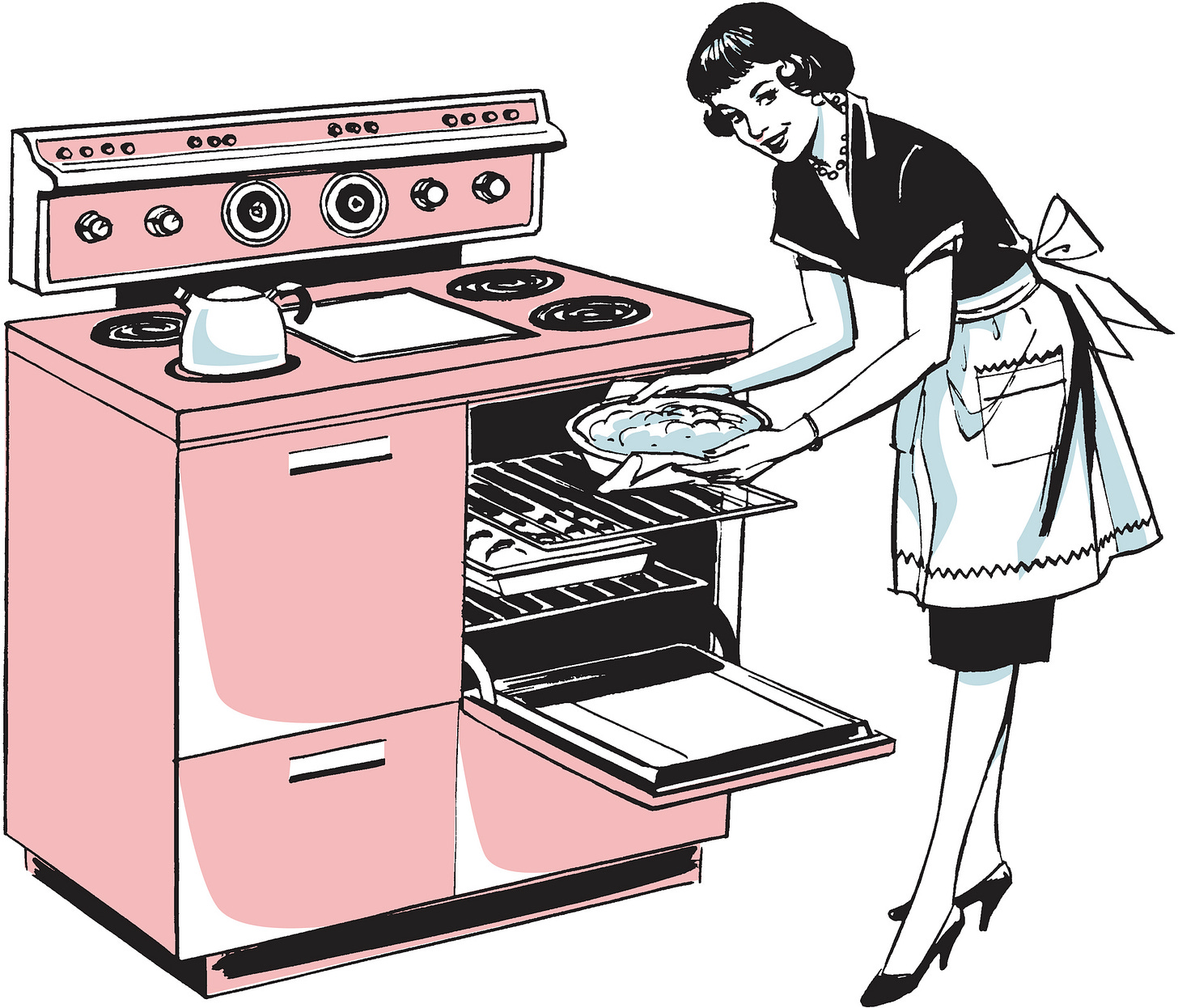
Hi! We actually do not live on Substack anymore, but will occasionally be posting here to remind you to visit us at our new home. You can sign up for a membership or a free subscription, here.
I didn’t panic until I cut open the plastic wrap covering the chicken. Bloody juices oozed into my sink. Holding my breath, I reached inside the clammy cavity and pulled out a long, thin package of giblets. Some part of my brain knew I was supposed to preserve them for a gourmet purpose, but I couldn’t hold them for more than a second without tossing them into the trash.
I rinsed the bird under the sink and patted it dry as the recipe instructed, telling myself the worst was over. Siri had stopped responding to my dictation requests. I had enabled her for the first time this afternoon, for the sole purpose of taking notes while my hands were covered in salmonella. But all she registered was my useless opening statement: “The scariest part was cutting open the chicken.” No, Siri, that was not the scariest part.
I am 40 years old and have never cooked a whole chicken. Yes, I regularly roast thighs and stir-fry breasts and boil assorted body parts into chicken soup. But a whole bird frightens me. How do you know it will cook evenly? How do you season it? How do you reach inside it without gagging?
If I could learn to roast a whole bird, it would feel like a small, important victory for adulthood.
Turning 40 makes you consider a lot of things: the state of your career, your fertility, your retirement account. On a good day, only two of those things keep me awake at night. But if I could learn to roast a whole bird, it would feel like a small, important victory for adulthood. I hate spending money on rotisserie chickens from the grocery store, which stink up my fridge. I often want chicken soup on a random weeknight, and having a chicken carcass around would really help. This past Christmas, my mother-in-law ordered a pre-smoked turkey because she didn’t feel like cooking one. I was unable to volunteer because I didn’t trust myself to cook one, either. In January, as my birthday approached, I decided enough was enough: It was time to roast a whole bird.
I began, of course, by procrastinating. Before I bought a chicken, I ordered a stainless steel meat thermometer. Then I took a few days to buy a humanely raised bird and select a recipe. The internet is full of complicated approaches— brining the bird in buttermilk overnight, browning the chicken in a saucepan and deglazing it with wine. I chose the simplest method I could find, outlined in the book I have relied on for 20 years: Clueless in the Kitchen: A Cookbook for Teens. Sure, the title is insulting, but author Evelyn Raab (no relation) taught me the essentials: how to make chicken soup, a basic quiche, a stir-fry. If I wanted a recipe I couldn’t screw up, this was the place to start.
I mixed paprika, sage, cayenne pepper, and fresh rosemary with chunks of smashed, peeled garlic, a few shakes of kosher salt and ground pepper, and a tablespoon of olive oil and began basting four pounds of chicken. Everything seemed OK, except chunks of garlic kept falling off their perch. The recipe said to baste the bird inside and out. But wouldn’t the herbs taste best on the skin? I stuffed some garlic inside just in case, far more concerned about covering an ever-expanding canvas of leg and thigh. I ran out of paste before I remembered I had neglected the chicken’s underside. Would the whole thing be dry and tasteless?
My husband chose this moment to walk into the kitchen with a scratch on the side of his face from pruning tree limbs outside. “Don’t use this sink!” I shouted, ignoring the blood trickling toward his eyebrow.
After washing and re-washing my own hands, I decided to grab a piece of twine from the kitchen drawer—not clean twine, of course; it had been used to wrap a present. I used it to tie the chicken legs together. (My husband assured me it would be fine, unless it caught fire). The recipe said trussing was not absolutely essential, but with my luck, I knew random pieces of chicken would remain cold and uncooked if I didn’t do it. So I tied a knot with string, shoved the whole thing into the oven at 375 degrees, and felt inordinately proud. Then I began to pray. Please let it have some flavor. Burnt chicken I could handle; bland chicken I could not.
I cook because I want a tangible accomplishment at the end of the day. No matter how many bills pile up or stories fall through, a meal is an undeniable fact. You can touch it, smell it, use it to nourish your family. When else does a typical weekday result in such an achievement?
The problem with seeking that ego boost is that it discourages you from trying new things. That’s a habit I would like to break.
After 70 minutes, the bird was reddish and oozing juices. I had vacuumed that morning, so the house was clean and smelled of garlic and paprika. I had an overwhelming sense of contentment as if someone else was in charge—a 1950s housewife, perhaps.
After 90 minutes, I stabbed a meat thermometer into the thickest section of a thigh. It read 180 degrees, and the leg jiggled as the recipe said it would. The juices were clear and the skin of the chicken was auburn and crispy. I took the bird out of the oven and let it cool while the vegetables finished roasting. I cut off a leg; my husband sampled the breast meat.
My first bite was discouraging. The chicken was perfectly cooked but didn’t taste much like garlic or rosemary. The skin was crispy but not particularly flavorful. The ho-hum taste was unnervingly similar to the rotisserie chickens I buy at the grocery store. How do you make a bird taste as good as it smells? I had no idea.
Two days later I was rushing off to an appointment and didn’t have time to make lunch. I grabbed the remaining chicken from the fridge, pulled off a wing, and ate it cold. It was surprisingly delicious—more garlicky than I remembered. The leftovers weren’t bad for dinner that night, either. The next day, I made a sandwich out of the few remaining bits of breast meat, tomatoes, and sauteed bok choy. I hadn’t planned on eating more chicken. It was just sitting there, appealing to my sense of laziness and desire to avoid the grocery store. That’s five meals and a snack (including dinner for two, lunch for one) that I’d gleaned from a single animal that cost $12. On the fifth day, I made a broth from the carcass, cutting up an onion, garlic, and carrots to make a soup base that could sit in my freezer until the next time I had a cold.
The practical advantages of roasting a whole chicken were becoming clear … It’s economical and efficient and perhaps the most useful thing I created all week.

The practical advantages of roasting a whole chicken were becoming clear. Having one in your fridge allows you to avoid lunch meat and frozen foods. It’s economical and efficient and perhaps the most useful thing I created all week. In other words, a minor miracle for adulthood.
Still, I wanted a chicken that tasted good from the first bite. By the following Sunday I was sick of chicken, and brainstorming ways not to eat the bird I was about to cook. I never liked chicken that much anyway—why did I sign up for this again? However, I never tire of wine and garlic, so I chose a recipe that used them both. It happened to be Mark Bittman’s recipe from How to Cook Everything (he’s paying this check, after all). If his recipe didn’t work, I would have to quit and become a vegetarian. I didn’t think I could stomach a third chicken.
This time, I was less squeamish about the raw bird. I dumped the juices and giblets into the sink, rinsed the bird, and patted it dry without gagging. I sprinkled it with salt and pepper, then decorated it with sprigs of fresh rosemary and thyme. Then I tossed seven cloves of garlic into the bottom of a cast-iron skillet along with half a cup of wine. The aroma of herbs and wine was exquisite. Moments after I put the chicken in the oven, it smelled like I had transformed into a gourmet chef. But as I had already learned, scents can be misleading.
Because the skillet was preheated (along with the oven) at 450 degrees, the wine immediately began to burn off. Twenty minutes later, I mixed a quarter cup of olive oil with chopped parsley and spooned it over the chicken, along with a bit more wine. Bittman warned the wine might reduce the browning of the chicken, but I was more interested in flavor than perfectly bronzed skin. The pan stopped smoking and the chicken began oozing fat and juices.
After 45 minutes, the meat thermometer read 160 degrees, but the juices were red, so I let it cook five more minutes, as instructed. The bird appeared to be perfectly brown and smelled magnificently of roasted garlic and herbs. After 13 more minutes, the juices were clear. My husband transferred the bird to a platter—a crucial skill I haven’t mastered—and began carving.
This chicken immediately tasted better than the first. The roasted garlic and fresh parsley gave it a richer, more complex flavor. But for some reason the skin wasn’t crispy. Perhaps too much fat leaked out and softened the skin? Maybe I didn’t let it rest long enough?
I felt frustrated and vaguely disappointed. A familiar mantra played in my head: This chicken isn’t perfect; I’m not good enough. As author Ada Calhoun discovered in her book, Why We Can’t Sleep, this general dissatisfaction is a malaise for middle-aged women of my generation, the Gen X-ers who grew up being told they could have it all and still judge themselves by impossible standards. I did not need to add “mediocre chef” to my list of self-criticisms.
I wanted the thrill of mastering a new skill. I wanted to conquer the chicken! I had already researched two more recipes that would help work out the kinks …
But I really couldn’t handle eating more chicken. Maybe it was time to stop. Cooking a whole bird no longer frightened me. I could even imagine tackling a Thanksgiving turkey someday. And that was kind of the point, wasn’t it? To try something new and prove I could do it. To set aside perfection in favor of a grown-up meal that would comfort and feed my family. Maybe for now, that was enough.






